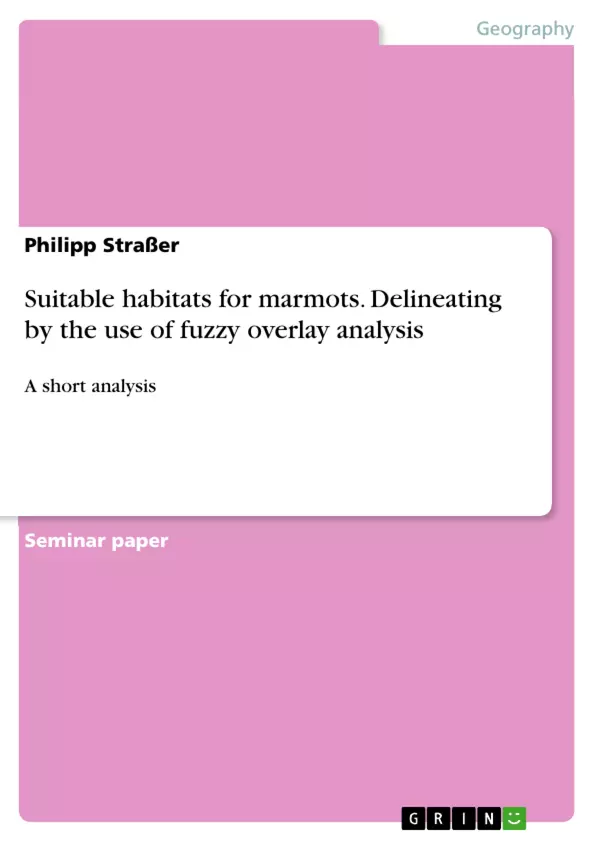In this paper the concept of fuzzy overlay was used to delineate suitable habitats for alpine marmots in the Dachstein region in Upper Austria. Four criteria were chosen as important factors for possible habitats for marmots: grassland as preferred type of biotope, an elevation between 800 and the foot of the glacier, the mean annual sunshine duration as well as the distance to skiing areas. By applying fuzzy membership values from 0-1 and overlaying the derived raster, a map with continuous suitability values is obtained. For decision making and finding the optimal areas defuzzification as well as a sorting out concerning the size of the areas is necessary as a final step.
Fuzzy overlay analysis is an interesting approach concerning multi criteria overlay analysis. By using fuzzy sets instead of crisp boundaries, fuzzy logic allows partial membership and multiple membership. This makes it ideal to overcome uncertainties in data and in the definition of classes.
Inhaltsverzeichnis (Table of Contents)
- Abstract
- Introduction
- Fuzzy Overlay Approach
- Examples for the Use of Fuzzy Overlay
- Study Area
- Alpine Marmots and Their Criteria for a Suitable Habitat
- Datasets for the Analysis
- Data Preparation
- Fuzzy Overlay Analysis
- Fuzzy Membership
- Fuzzy Overlay
- Defuzzification
- Result and Conclusion
- References
- Table of Figures
Zielsetzung und Themenschwerpunkte (Objectives and Key Themes)
This work aims to determine the potential range of alpine marmots in the Dachstein region of Upper Austria using fuzzy overlay analysis. The objective is to identify the best habitat for marmots within this potential range. The study focuses on the application of fuzzy logic, which allows for partial and multiple memberships, to overcome uncertainties in data and class definitions.
- Fuzzy overlay analysis as a tool for delineating suitable habitats.
- Application of fuzzy logic in spatial analysis.
- Identifying criteria for suitable marmot habitats.
- Analyzing spatial data to determine potential marmot range.
- The advantages of fuzzy overlay analysis compared to traditional methods.
Zusammenfassung der Kapitel (Chapter Summaries)
- The abstract introduces fuzzy overlay analysis as a method to delineate suitable habitats for species, with a specific focus on alpine marmots in the Dachstein region of Upper Austria.
- The introduction explains the objective of the study, highlighting the need to identify potential range and best habitat for marmots in the Dachstein region. It introduces fuzzy overlay as a key method for achieving this.
- The fuzzy overlay approach chapter describes the principles of fuzzy logic and how it contrasts with traditional suitability analysis methods. It emphasizes the advantages of fuzzy overlay, such as handling uncertainties and allowing partial memberships.
- Examples for the use of fuzzy overlay highlights various applications of this approach, including identifying suitable nesting locations for sage grouses, predicting suitable habitats for zombies in scenarios, and modeling the distribution of invasive species.
- The study area chapter describes the „FFH- und Vogelschutzgebiet Dachstein\" area, a protected area in Upper Austria, chosen as the study area due to its location, biotopes, and data availability.
Schlüsselwörter (Keywords)
This study focuses on the application of fuzzy overlay analysis for determining suitable habitats for alpine marmots in the Dachstein region of Upper Austria. Key concepts include fuzzy logic, suitability analysis, spatial data, habitat suitability, potential range, and species distribution modeling.
- Quote paper
- Philipp Straßer (Author), 2018, Suitable habitats for marmots. Delineating by the use of fuzzy overlay analysis, Munich, GRIN Verlag, https://www.hausarbeiten.de/document/585271


